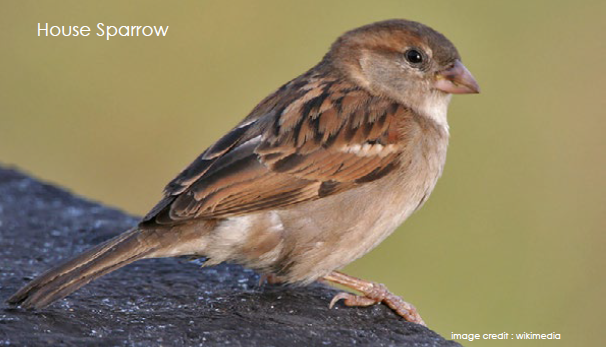
Sparrows of India!

Sparrows of India!
The House Sparrow (Passer Domesticus) is found naturally in most of Europe, the Mediterranean region, and much of Asia. This species has also been intentionally or accidentally introduced to many parts of the world, making it the most widely distributed wild bird. It is a small bird, with feathers mostly different shades of brown and grey. The House Sparrow is a very social bird and is gregarious at all seasons when feeding, often forming flocks with other types of bird. It roosts communally, its nests are usually grouped together in clumps, and it engages in a number of social activities, such as dust and water bathing, and “social singing“, in which birds call together in bushes.
A Widespread resident, except in parts of NorthEast and North West sub-continent, the Male has grey crown, black throat and upper breast, chestnut nape, and brownish mantle.The female has buffish supercilium and unstreaked greyish-white underparts. Breeds in Habitation; also cultivation in winter.
Measurements , shape and Plumage
The house sparrow is typically about 16 cm (6.3 in) long, ranging from 14 to 18 cm (5.5 to 7.1 in). It is a compact bird with a full chest and a large, rounded head. Its bill is stout and conical with a culmen length of 1.1–1.5 cm (0.43–0.59 in), strongly built as an adaptation for eating seeds. Its tail is short, at 5.2–6.5 cm (2.0–2.6 in). The wing chord is 6.7–8.9 cm (2.6–3.5 in), and the tarsus is 1.6–2.5 cm (0.63–0.98 in). In mass, the house sparrow ranges from 24 to 39.5 g (0.85 to 1.39 oz). Females usually are slightly smaller than males. The median mass on the European continent for both sexes is about 30 g (1.1 oz), and in more southerly subspecies is around 26 g (0.92 oz). Younger birds are smaller. Males are larger during the winter, and females are larger during the breeding season. Birds at higher latitudes, colder climates, and sometimes higher altitudes are larger, both between and within subspecies.
The plumage of the house sparrow is mostly different shades of grey and brown. The sexes exhibit strong dimorphism: the female is mostly buffish above and below, while the male has boldly coloured head markings, a reddish back, and grey underparts. The male has a dark grey crown from the top of its bill to its back, and chestnut brown flanking its crown on the sides of its head. It has black around its bill, on its throat, and on the spaces between its bill and eyes (lores). It has a small white stripe between the lores and crown and small white spots immediately behind the eyes (postoculars), with black patches below and above them. The underparts are pale grey or white, as are the cheeks, ear coverts, and stripes at the base of the head. The upper back and mantle are a warm brown, with broad black streaks, while the lower back, rump and
uppertail coverts are greyish brown.
Distribution & Habitat
The house sparrow originated in the Middle East and spread, along with agriculture, to most of Europe, Asia and parts of North Africa. Since the mid-19th Century, it has reached most of the world, chiefly due to deliberate introductions, but also through natural and ship borne dispersal. Its introduced range encompasses most of North America, Central America,
southern South America, southern Africa, part of West Africa, Australia, New Zealand, and islands throughout the world. It has greatly extended its range in northern Eurasia since the 1850s, and continues to do so, as was shown by the colonisations around 1990 of Iceland and Rishiri Island, Japan. The extent of its range makes it the most widely distributed wild bird on the planet.
The house sparrow is closely associated with human habitation and cultivation. Central Asian house sparrows usually breed away from humans in open country, and birds elsewhere are occasionally found away from humans. The only terrestrial habitats that the house sparrow does not inhabit are dense forest and tundra. Well adapted to living around humans, it frequently lives and even breeds indoors, especially in factories, warehouses, and zoos.
It tolerates a variety of climates, but prefers drier conditions, especially in moist tropical climates. It has several adaptations to dry areas, including a high salt tolerance and an ability to survive without water by ingesting berries.
Sind Sparrow
The Sind sparrow (Passer pyrrhonotus) is a passerine bird of the sparrow family Passeridae, found around the Indus valley region in South Asia. It is also known as the jungle, Sind jungle, or rufous-backed sparrow. Very similar to the related house sparrow, it is smaller and has distinguishing plumage features. As in the house sparrow, the male has brighter plumage than female and young birds, including black markings and a grey crown. The male has a distinctive chestnut stripe running down its head behind the eye, and the female has a darker head than other sparrow species do. Its main vocalisations are soft chirping calls that are extended into longer songs with other sounds interspersed by breeding males. Historically, this species was thought to be very closely related to the house sparrow, but its closest evolutionary affinities may lie elsewhere. Discovered around 1840, this species went undetected for several decades after its
discovery.
Measurements, Shape and Plumage
The Sind sparrow is very similar to the house sparrow, and both sexes resemble their
counterparts of that species, but it is slightly smaller and males and females each have features that distinguish them as Sind sparrows. The Sind sparrow is 13 cm (5.1 in) long, while the common South Asian subspecies of the house sparrow, ‘Passer Domesticus Indicus’, is about 15 cm (5.9 in) long. Wingspans range from 6.2 to 7.0 cm (2.4 to 2.8 in), tails from 4.7 to 5.7 cm (1.9 to 2.2 in), and tarsi measure 1.6–1.9 centimetres (0.63–0.75 in).
The breeding male has a short and narrow black bib and a broad chestnut eye stripe that does not meet the mantle. The male has a grey crown and nape and a rufous lower back and rump. The female has a darker and greyer crown and cheek than the female house sparrow and the shoulder is darker chestnut. The female Dead Sea sparrow of the subspecies
Passer moabiticus yattii is also similar to the female Sind sparrow, but has yellow tinges on the underparts and sometimes on parts of the head.The bill is black on the breeding male and pale brown on the non-breeding male and female. With a culmen length of 1.1–1.3
centimetres (0.43–0.51 in), the Sind sparrow is slightly smaller-billed than the house sparrow.
Distribution & Habitat
Within its Indus valley breeding range in Pakistan and Western India, the Sind sparrow is patchily distributed in riverine and wetland habitats with thorny scrub and tall grass. During the non-breeding season, some birds enter drier habitats as they disperse short distances from their breeding habitat, or migrate into western Pakistan and the extreme east of Iran. Since this species is fairly common and expanding its range, it is assessed as least concern on the IUCN Red List. The Sind sparrow is social within small groups while feeding and breeding, and during its winter dispersal. It feeds mostly on seeds and less
often on insects, foraging close to the ground. Nests are made in the branches of thorny trees, and are untidy globular masses constructed from grass or other plant matter and lined with softer material. Both sexes are involved in building the nest and caring for the young, and usually raise two clutches of three to five young each breeding season.
The Sind sparrow has a restricted distribution, primarily occurring within the Indus valley of Pakistan, and the lower parts of the tributaries of the Indus in the Punjab region. Its distribution extends from the Indus Delta north to the Kabul River near Nowshera and the Jhelum near Nurpur Noon, extending East into India as far as the Delhi area. It also breeds locally in parts of Pakistan’s western province of Balochistan, and has been recorded several times in South-Eastern Iran. The Sind sparrow is somewhat common in its restricted breeding range,and no threats are known to the survival of the species, so it is assessed as least concern on the IUCN Red List.
During winter, it often makes short distance movements, and some birds move into parts of western Pakistan and an adjoining corner of Iran, and less commonly north-western Gujarat. Longer movements may occur, as suggested by a possible sighting in the United Arab Emirates in November 2000.
It mostly breeds in acacia and tamarisk scrub and tall grass, invariably near rivers or other wetlands. The construction and expansion of irrigation canals has increased its habitat in Sindh, and helped it extend its range into the Yamuna floodplain and parts of Rajasthan.It may breed around rice paddies and other fields, or human habitations, provided that there is enough cover and suitable nesting sites. In winter, it moves away from its main riverine habitat, and into drier thickets characterised by Salvadora and Capparis bushes, but never moves too far from water.
Spanish Sparrow
The Spanish sparrow or willow sparrow (Passer Hispaniolensis) is a passerine bird of the sparrow family Passeridae. It is found in the Mediterranean region and south-west and central Asia. It is very similar to the closely related house sparrow, and the two species show their close relation in a “biological mix-up” of hybridisation in the Mediterranean region, which complicates the taxonomy of this species.
Measurements, Shape and Plumage
The Spanish sparrow is a rather large sparrow, at 15–16 cm (6–6.5 in) in length, and 22–36 g (0.78–1.27 oz) in weight. It is slightly larger and heavier than house sparrows and also has a slightly longer and stouter bill. The male is similar to the house sparrow in plumage, but differs in that its underparts are heavily streaked with black, has a chestnut rather than grey crown, and has white rather than grey cheeks. The female is effectively inseparable from house sparrow in its plumage, which is grey-brown overall but more boldly marked. The female has light streaking on its sides, a pale cream supercilium, and broad cream streaks on its back.
The two subspecies differ little in worn breeding plumage, but both sexes are quite distinct in fresh winter plumage, with the eastern subspecies P. h. transcaspicus paler with less chestnut.
Distribution & Habitat
The Spanish sparrow has a highly complex distribution in the Mediterranean region, Macronesia, and south-west to central Asia. It breeds mostly in a band of latitude about fifteen degrees wide, from the Danube valley and the Aral Sea in the north to Libya and central Iran in the south. Its range has expanded greatly by natural colonisation over the last two centuries, in the Balkans, where it reached Romania, Serbia, and Moldova from 1950 onwards; and in Macronesia, where its range expansion has been attributed to introductions and travel by ship, but was more likely natural colonisation by migrating birds. Vagrants occur widely, as far north as Scotland and Norway.
The Eastern subspecies transcaspicus breeds from Anatolia and Cyprus through the Middle East and Central Asia to far Western China. In the Middle East it breeds through Syria and Lebanon to about as far South as Jerusalem. It breeds in Eastern Turkey, but is a very rare breeder in Iraq and Kuwait. It breeds sporadically in Azerbaijan and Dagestan, North of the Terek River valley. In Iran, it breeds across most of the country except the Persian Gulf region, also breeding in Central and Northern Afghanistan. In Central Asia, it breeds from the regions of the Turkmenistan-Iran and Tajikistan-Afghanistan borders North to parts of the Syr Darya basin in Kazakhstan, and Westwards to Lake Alakol, the Karatal River, and a corner of China. Here it has also expanded its range, in the area around Lake Alakol in Kazakhstan, where agriculture was not developed until the 1950s. It winters in the plains of the Indian subcontinent and the Persian Gulf.
In most of its range, the Spanish sparrow occurs alongside the house sparrow. In such areas, both species breed in farmland and open woodland, with the Spanish sparrow preferring moister habitats. In areas where house sparrows are absent, the Spanish sparrow may live in urban habitats, as in the Canary Islands, Madeira, and some Mediterranean islands. In a few urban areas, such as those in eastern Sardinia, the primary sparrow species is the Eurasian tree sparrow. Before the Spanish sparrow arrived in the Canary Islands and Madeira, the rock sparrow was the sole native sparrow. In the Canaries, the Spanish sparrow occurs in most habitats, having ousted the rock sparrow from all but the driest localities. In Madeira the Spanish sparrow is common in cultivated areas, but it has not fully adapted to nesting in buildings or breeding in the drier north of the island.
Russet Sparrow
The Russet sparrow (Passer Cinnamomeus), also called the cinnamon or cinnamon tree sparrow,is a passerine bird of the sparrow family Passeridae. Three subspecies are recognised,differing chiefly in the yellowness of their under parts. The subspecies rutilans and intensior breed in parts of Eastern Asia, where they are usually found in light woodland, and the
subspecies cinnamomeus breeds in the Himalayas, where it is usually associated with terrace cultivation. The Russet sparrow is the typical sparrow of human habitations in towns where the house and Eurasian tree sparrows are absent. In the southern part of its range, the russet sparrow prefers higher altitudes, but in the north it breeds by the sea. The Russet sparrow is known well enough in the Himalayas to have a distinct name in some languages, and is depicted in Japanese art.
Measurements , shape and Plumage
The Russet sparrow is a small chunky bird, with plumage warm rufous in overall colour. It is a medium-sized sparrow at 14 to 15 cm (5.5–5.9 in) and 18 to 22.5 grams (0.63–0.79 oz). It has a thick bill suited to eating seeds, which is black on the breeding male, horn-coloured on the non-breeding male, and yellowish with a dark tip on the female. Wingspans for males range between 6.8 to 8.2 cm (2.7–3.2 in) and those for females from 6.7 to 7.7 cm (2.6–3.0 in). Tail, bill, and tarsus lengths are 4.3 to 5.1 cm (1.7–2.0 in), 1.1 to 1.3 cm (0.43–0.51 in), and 1.6 to 1.8 cm (0.63–0.71 in), respectively.
Measurements for the Russet sparrow vary geographically, between the three sub-species,and also within the Himalayan sub-species cinnamomeus. The sub-species cinnamomeus is generally larger than the others, and within this form there is a tendency for birds at higher altitudes to be larger, and a clinal variation in size with the smallest birds in the west of the range and the largest in the East. The iris is chestnut in colour. The legs of both sexes are pale brown to pinkish-brown. The flight of all sparrows is swift, and that of the russet sparrow is described as swifter and more direct than that of the Eurasian tree sparrow.
The sexes differ, or are dimorphic, in their plumage, and have a similar pattern to that in the corresponding sex of house sparrow. There is some variation between the three subspecies, especially in the colouration of the under parts. Birds of the subspecies rutilans are off-white on their cheeks and the sides of their necks, and have pale grey under parts. Birds of the
subspecies intensior have a pale yellow wash on their under parts and cheeks, as well as darker upper parts, while those of the subspecies cinnamomeus have a heavy yellow tinge to their under parts.
The breeding male is bright russet or cinnamon red on its upper parts from its crown to its rump, with a black streaking on its mantle. It has a small black bib and black around its eye, separated from the russet of its crown by a very thin white supercilium, a stripe running from the bill to the rear of the head. The side of its neck and cheek are off-white, and it’s
under parts are pale grey or washed with yellow, varying geographically. Shoulders and greater coverts are chestnut, and its median coverts are black at the base with white at the tips. The rest of the wing is light brown with black tinges. Its tail is blackish brown, edged with ashy brown. The non-breeding male differs little from the breeding male, being paler with more orange upper parts. The only species with which the male is easily confused is the Eurasian tree sparrow, which differs in its black cheek spot and brown back.
The female has mostly pale brown upper parts, and pale grey under parts, so it resembles the female house sparrow. It differs from the house sparrow in its slightly darker, russet-tinged plumage. It has a conspicuous cream supercilium from above its eye nearly around its head, and a bold dark brown stripe through its eye. It has mostly greyish brown wings and a back streaked with black and buff. The juvenile is similar to the female, though more pale and sandy. As the male reaches its first winter, it resembles the adult, differing in less bold chestnut and a dusky bib.
Distribution & Habitat
The Russet sparrow is found in parts of Eastern Asia and in the Himalayas. It is not known whether its distribution is continuous between these two areas, since the political sensitivity of the Brahmaputra River’s valley near the China-India border makes the area less accessible to ornithologists. In the Himalayas the Russet sparrow breeds from the far northeast of India through south-eastern Tibet, Bhutan, Sikkim, Nepal, Uttarakhand, and Himachal Pradesh to Kashmir and Nuristan in Afghanistan. Here, the Russet sparrow makes short movements to lower altitudes between November and April in many areas.
In Eastern Asia, the Russet sparrow is found in Sakhalin, the Kuril Islands, a small part of mainland Russia, Japan, Southern Korea, and part of Northern China, where it is mostly migratory. It is distributed through Southern China and Taiwan, and the mountainous parts of Burma, Southern North East India, Laos, and Vietnam, where it is mostly resident. The Russet sparrow also occurs as a winter visitor in southern Japan, the further south of China, and northern Thailand. In eastern Asia, the autumn migration occurs between August and November.
The Russet sparrow appears to be abundant in most habitats across most of its very large range, and in the some areas it is among the most common birds. In Southeast Asia, its range has contracted at lower elevations due to global warming, but it has also moved higher at high elevations and it remains common.
Breeding takes place in mountains and uplands across most of the range. This preference for high altitudes is influenced by latitude: in the farthest South of its range it never breeds below 2,500 metres (8,200 ft) above mean sea level, but in the
northernmost part of its range it often breeds by the sea. In eastern Asia, the Russet sparrow prefers light woodland, but it is sometimes found in towns and agricultural areas.
In the Himalayas, it is strongly associated with terrace cultivation, and it probably only spread to the Himalayas when these agricultural practices arrived 3000 to 4000 years ago. In towns where it occurs alongside the house or tree sparrow, it is found in gardens and less built up areas. In those hill stations in India where both the house and the russet sparrow occur, the house sparrow breeds around more -built up areas and bazaars, whereas the russet sparrow is “rather more up market at the larger houses with gardens and open spaces”. In towns where it is the only sparrow, it is not dependent on trees, breeding around houses and eating scraps in streets. In the winter, migratory birds occur in open cultivated land and riverine grasslands, but are never far from shrubs or trees.
The Eurasian Tree Sparrow
The Eurasian tree sparrow (Passer Montanus) is a passerine bird in the sparrow family with a rich chestnut crown and nape, and a black patch on each pure white cheek. The sexes are similarly plumaged, and young birds are a duller version of the adult. This sparrow breeds over most of temperate Eurasia and Southeast Asia, where it is known as the tree sparrow, and it has been introduced elsewhere including the United States, where it is known as the Eurasian tree sparrow or German sparrow to differentiate it from the native unrelated American tree sparrow. Although several subspecies are recognised, the appearance of this bird varies little across its extensive range.
Measurements , Shape and Plumage
The Eurasian tree sparrow is 12.5–14 cm (5–5 1⁄2 in) long, with a wingspan of about 21 cm (8.3 in) and a weight of 24 g (0.85 oz), making it roughly 10% smaller than the house sparrow. The adult’s crown and nape are rich chestnut,and there is a kidney-shaped black ear patch on each pure white cheek; the chin, throat, and the area between the bill and throat are black. The upper parts are light brown, streaked with black, and the brown wings have two distinct narrow white bars. The legs are pale brown, and the bill is lead-blue in summer, becoming almost black in winter.
This sparrow is distinctive even within its genus in that it has no plumage differences between the sexes; the juvenile also resembles the adult, although the colours tend to be duller. Its contrasting face pattern makes this species easily identifiable in all plumages; the smaller size and brown, not grey, crown are additional differences from the male house sparrow. Adult and juvenile Eurasian tree sparrows undergo a slow complete moult in the autumn, and show an increase in body mass despite a reduction in stored fat. The change in mass is due to an increase in blood volume to support active feather growth, and generally higher water content in the body.
Distribution & Habitat
The Eurasian tree sparrow’s natural breeding range comprises most of temperate Europe and Asia South of about latitude 68°N (North of this the summers are too cold, with July average temperatures below 12 °C) and through Southeast Asia to Java and Bali. It formerly bred in the Faroes, Malta and Gozo. In South Asia it is found mainly in the temperate zone. It is sedentary over most of its extensive range, but northernmost breeding populations migrate south for the winter, and small numbers leave southern Europe for North Africa and the Middle East. The eastern sub-species Passer Montanus dilutus reaches coastal Pakistan in winter and thousands of birds of this race move through Eastern China in autumn.
The Eurasian tree sparrow has been introduced outside its native range, but has not always become established, possibly due to competition with the house sparrow. It was introduced successfully to Sardinia, Eastern Indonesia, the Philippines and Micronesia, but introductions to New Zealand and Bermuda did not take root. Ship-carried birds colonised Borneo. This sparrow has occurred as a natural vagrant to Gibraltar, Tunisia, Algeria, Egypt,
Israel, and Dubai.
Despite its scientific name, Passer montanus, this is not typically a mountain species, and reaches only 700 m (2,300 ft) in Switzerland, although it has bred at 1,700 m (5,600 ft) in the northern Caucasus and as high as 4,270 m (14,010 ft) in Nepal. In India it is spread out in the upper Himalayas, and the North eastern states. The Eurasian tree sparrow shows a strong preference for nest-sites near wetland habitats, and avoids breeding on intensively managed mixed farmland.
When the Eurasian tree sparrow and the larger house sparrow occur in the same area, the house sparrow generally breeds in urban areas while the smaller Eurasian tree sparrow nests in the countryside. Where trees are in short supply, as in Mongolia, both species may utilise man-made structures as nest sites. The Eurasian tree sparrow is rural in Europe, but is an urban bird in eastern Asia; in Southern and Central Asia, both Passer species may be found around towns and villages. A&W












